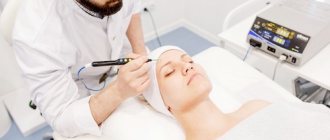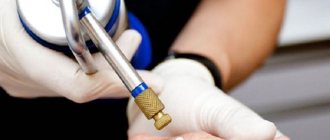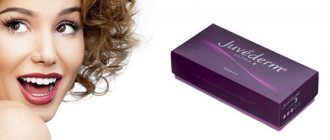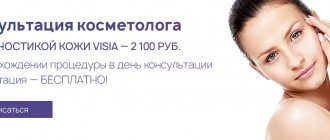The problem of the appearance of tumors on the skin of the face worries every person: tumor lesions cause discomfort and inconvenience and require cosmetic or therapeutic treatment. The capabilities of high-precision medical equipment and innovative techniques make it possible to effectively and safely remove tumors on the face. The most common, gentle and low-traumatic method that does not leave noticeable marks is laser removal of facial lesions.
Neoplasms on the face
Facial skin diseases are divided into two large groups: benign (papillomas, moles, angiomas) and malignant (sarcomas, melanomas). Let's consider a list of skin diseases that can be easily corrected using laser destruction:
- Hemangioma is a benign tumor of blood and lymphatic vessels that affects large areas of the skin surface and is a serious cosmetic problem.
- Basalioma - affects the skin of the face and wings of the nose. The causes have not been studied; it is not a dangerous disease.
- Warts are growths of various types and colors that are of viral origin.
- Botriomycoma is a benign formation, it is a red or bright pink nodule of different sizes; if damaged, bleeding occurs.
- Keratoma is keratinization of the layers of the epidermis, manifested by the formation of single or multiple plaques with a rough surface, prone to destruction. It is considered a borderline tumor in patients who belong to a risk group for the development of cancer.
- Nevus (mole) is a formation on the skin, characterized by an accumulation of melanocytes, and has a benign and malignant course.
- Chalazion is a disease of the eyelid and cartilage tissue around the eyes, a chronic proliferative process.
- Condylomas, papillomas are soft tissue papillary formations on a stalk that are caused by the human papillomavirus. Some strains are highly oncogenic and cause severe damage to the genitals and mucous membranes of the cervix (dysplasia).
- Lipoma is a tumor-like formation of adipose tissue.
- Acne is an inflammatory skin disease affecting the hair follicle and sebaceous gland.
- Cysts (milia).
Treatment methods for warts
Treatment of warts does not guarantee 100% results. Even a healed wart may reappear in the future. Removal of warts only in 70% of cases does not result in relapse after a while. The behavior of warts is unpredictable. Treatment of warts may often not bring any results, and in some cases the problem resolves on its own without any intervention at all.
Treatment of warts has two goals - destruction of the viral tumor, improving the quality of life for the patient. Indications for starting treatment are the clinical manifestation of the problem. The most common method is based on the destruction of education. However, there is no guarantee that after complete healing of the tissue in the affected area, the problem will not reappear. Most often, relapses are typical for neoplasms of a large area - from two centimeters. Warts on the fingers and in the area of the periungual plate are also considered problematic.
Warts are treated using several methods. The choice of a specific method for treating warts directly depends on the type of lesion, its prevalence, location and other factors. All interventions are carried out without mandatory hospitalization of patients.
Treatment of warts with physical destructive methods
- Electrocoagulation
. The affected area is numbed, then an electric current is applied to the wart using a needle tip. The method allows you to remove the wart layer by layer. - Cryodestruction
. Freezing the surface of the tumor using liquid nitrogen. The duration of exposure is from 1 to 5 minutes. A repeat procedure is required a week after the first. - Laser exposure
. Depending on the size of the wart, laser contact on the area lasts from a few seconds to 2-3 minutes. The crust formed on the surface is cut with scissors, then the bottom of the wart is re-exposed using a laser. The disadvantage of this method is that a wound surface is formed, which the patient needs to treat independently. The affected area should not be re-injured, and it is also important to avoid getting wet. The scab that appears on the surface is removed by the patient. - Radiosurgery
. The affected area is exposed to electromagnetic waves. As a result of this effect, the surface of the wart is dissected without mechanical force. The intervention is carried out with local anesthesia of the affected area. Most often, a 2% lidocaine solution is administered.
Treatment of warts with chemical methods
- Zinc solution. Before removing the wart, the doctor treats the surface with alcohol to disinfect and facilitate penetration of the composition. The solution is applied using a spatula or capillary, it all depends on the size of the wart. The duration of application is until the neoplasm changes its color. The procedure is repeated after 1-2 weeks. For ordinary warts, 1-2 procedures are most often sufficient; if we are talking about plantar warts, applying the solution may require three times. The wart tissue undergoes mummification under the influence of the composition, in order to increase the effectiveness of the effect; dead areas are removed before new application. During the periods between procedures, the patient is not recommended to wet the area. The surface is also subjected to antiseptic treatment using alcohol-free compounds.
- Composition based on nitric, acetic, oxalic, lactic acid and sodium nitrate trihydrate. In this method, the surface of the wart is also pre-degreased. It is important to apply the composition exclusively to the affected areas, without touching healthy tissue. The product turns tumors on the skin yellow and on mucous membranes white. The patient is required to return for an examination 3-5 days after treatment. The method is not suitable for warts that exceed 5 centimeters in diameter.
How to remove warts in childhood? Treatment is possible only with the help of destructive methods in order to avoid possible toxic effects on a fragile organism.
It is important to remember that it is easier to prevent the appearance of warts than to subsequently treat them in a clinic. There are several rules of prevention:
- Maintain personal hygiene, wash hands after visiting public places, use only personal items.
- If damage appears on the skin of the hands or feet, they must be treated with iodine or brilliant green until they heal. It is also advisable to limit contact with HPV carriers.
- Normalization of nutrition. The body must receive all the elements necessary for the normal development of the body. It is also important to remove stress from your daily life as much as possible.
Reasons for the appearance of tumors on the face
Neoplasms on the face can appear in people of different ages, even in those who monitor their skin condition. The risk category includes women over 35 years of age, when the body is forced to adapt to sudden hormonal changes. The main causes of facial skin lesions:
- involutive skin changes
- changes in the endocrine system
- pregnancy and lactation
- lack of vitamins
- autoimmune chronic diseases
- food and chemical poisoning
- smoking abuse
- UV radiation and solarium tanning
Types of warts
There are several types of formations. Basically, the division into types of warts is associated with the external aspect, the cause of occurrence and other factors. The following types of warts are distinguished:
- Ordinary (vulgar)
. This type of formation is characterized by an age limitation - predominantly the problem caused by HPV develops in childhood. Warts on the hands, fingers and toes are a common location for the problem. What a wart looks like - a colorless lump the size of a pin's head. Sometimes larger formations are possible. A viral wart rarely manifests itself as a single rash; most often you can find a whole scattering of neoplasms in the affected area. An interesting fact is that if the largest wart in the affected area is correctly removed surgically, the rest will disappear on their own over time. - Flat
. These types of warts mostly appear between the ages of 10 and 25. They are small papules that practically do not stand out above the skin. The surface of the wart is colorless, in some cases the skin in the affected areas acquires a yellowish tint. Viral warts most often appear on the back of the hand, hands, neck and face. - Plantar
. Most often, people with this problem have the question of how to get rid of warts. This is due to the fact that the rashes cause discomfort and pain, especially while walking. They mainly occur on the feet in places that experience excessive friction when walking. The main problem of such a neoplasm is difficulty in self-identification due to its appearance, which is very similar to ordinary plantar calluses. - Seborrheic
. The types of warts in this category are diagnosed in elderly patients. A distinctive feature of education is long-term formation, sometimes it takes several years. Appears as a dark brown small spot on the body, which gradually increases in size, eventually reaching a diameter of 5-6 centimeters. Warts are characterized by the presence of a greasy surface with crusts. Over time, the formation thickens, becomes covered with cracks and darkens significantly. Senile warts occur on closed areas of the body. - Condylomas
. It has a specific place of occurrence - in the area of the perineum and genitals. Warts can also be found in the armpits, under the breasts in women, and in the area of the nasolabial triangle in children. They got their name due to their pointed and lobed structure. Such warts are characterized by multiple distribution in the affected area - the rash is never isolated. The color of the new growth is colorless or pale pink. In some cases, warts begin to rub against clothing or other objects, eventually become damaged, become purple in color, and begin to bleed.
Is it necessary to remove lesions on the face?
The development of benign tumors creates a lot of inconvenience and is an unpleasant aesthetic problem. To avoid the development of serious complications (inflammatory processes, the appearance of ulcers, bleeding), as well as the growth of the lesion, doctors recommend removing formations on the face.
In the case of moles, refusal to remove them altogether risks the appearance of cancer, the treatment of which will require more significant medical care. In addition, untimely intervention in the oncological development of a neoplasm is highly likely to result in death.
Why surgery may be needed
Excision of skin tumors can be carried out for both aesthetic and medical reasons.
Benign neoplasms are usually not dangerous to the life and health of the patient. However, in some cases, for example, when they are traumatized, there is a risk of the tumor degenerating into a malignant one.
You should definitely see a doctor in the following cases:
- Active growth of the tumor is observed.
- There is bleeding or pain.
- Due to its location, the formation is subject to constant trauma.
If the doctor suspects that your tumor may be malignant, a consultation with an oncologist is required, as well as a series of diagnostic procedures to clarify the diagnosis.
Neoplasms are not removed in the following cases:
- Childhood.
- Acute inflammatory or infectious diseases in the acute stage.
- Serious abnormalities in the functioning of the nervous system, mental disorders.
- Psoriasis or other skin diseases in the acute stage.
- Blood diseases, including bleeding disorders.
We also note that doctors do not recommend performing surgery on girls during menstruation.
Methods for removing tumors on the face
To eliminate the problem of the appearance of benign tumors, laser removal of formations on the face is used. A cosmetic defect can be eliminated in several sessions. The main goal of the laser procedure is to relieve the patient from an unpleasant facial skin disease, prevent malignant degeneration, obtain an effective cosmetic result, avoid the formation of scar tissue and scars, and prevent relapses.
Laser removal of tumors on the face has a list of advantages:
- quick and painless method
- eliminating the risk of bacterial contamination
- suitable for sensitive skin with contraindications to the use of other technologies
- short rehabilitation period
- no injuries or bleeding
- use of local anesthesia
- the method is suitable for removing defects in hard-to-reach places: corners of the nose, nasal cavity, eyelid area
- the use of technology promotes epidermal regeneration
Rehabilitation period
As a rule, a couple of hours after surgery, the patient can go home. To reduce the risk of complications and undesirable consequences, it is recommended to follow the following rules:
- Daily dressing change, antiseptic wound treatment.
- For prevention purposes, the doctor may prescribe antibacterial or anti-inflammatory drugs.
- In order to speed up wound healing, regenerating ointments or creams can be prescribed.
- For 10 days after surgery, it is recommended to avoid increased physical activity, taking baths, visiting bathhouses and swimming pools.
More detailed information about the excision of tumors of the skin and subcutaneous tissue can be obtained during an in-person consultation with a specialist. Be healthy!
Contraindications for laser treatment of tumors
Laser removal of formations on the face cannot be used for the following pathological conditions:
- increase in tumor size
- changes in color, shape, structure of the tumor focus
- formation of cracks, ulcers, skin hyperemia, bleeding
- inflammation
- the appearance of pain
With such symptoms, it is appropriate to assert that the formation is oncological in nature and intervention is necessary in other ways, for example, with a radio wave device, followed by histology of the tumor.
Diagnostics and examinations
Pigmented nevi, keratomas, condylomatous growths, and papillomas deserve special attention. Removing tumors on the face with a laser requires a microscopic analysis of the tissue.
Important! If malignant degeneration is suspected, the doctor performs dermatoscopy. It is forbidden to take a tissue biopsy before removal, so as not to provoke the development of a cancerous tumor.
Laser removal mechanism
The laser beam is able to carefully remove the formation without damaging adjacent tissue. The laser radiation beam penetrates the skin to a depth of 1 micron and works in a targeted manner, which prevents the occurrence of burns and microtraumas. The method is especially suitable for small areas of skin, for example, for removing tumors on the nose. The doctor prescribes from 2 to 4 sessions, the number of procedures for each case individually. Additional correction may be required after a month. The duration of one procedure is about 20 minutes and depends on the severity of the lesion.
Preparatory activities
Beginning the course of restoring beautiful and elastic skin requires additional measures. Need to:
- avoid prolonged sun exposure before and after treatment
- do not visit saunas, baths, do not swim in hot water
- refrain from cosmetic peelings
- treat affected areas with sunscreen
- do not use medications that affect the blood clotting system
What should you do after a laser therapy session?
The procedure is performed on an outpatient basis and does not require a hospital stay. During the rehabilitation period, you should refrain from exposure to the sun or solarium. At the site of the tumor, a crust forms, which should not be injured, as this can lead to the formation of a residual mark, which, however, can be easily removed by dermabrasion or laser resurfacing. Under no circumstances should the wound be wetted or allowed to soak the crust covering it. It is advisable to treat it with alcohol-based antiseptics.
The result of laser treatment and compliance with all the measures described above will be clear and smooth skin without scars. The price of laser removal of tumors on the face depends on the area and type of lesion, and is calculated individually for those wishing to receive high-quality treatment. General prices are listed below.
You can ask additional questions to a specialist at the medical center, and make an appointment with a dermatologist. ABC Clinic specialists perform effective removal of tumors of various etiologies using new equipment and guaranteeing the absence of relapses.
Primary source honey / September 2018
Is preparation necessary?
Even the removal of a small skin tumor is considered a full-fledged surgical intervention. For this reason, before surgery, it is mandatory to undergo a preoperative examination, which includes:
- General blood and urine analysis.
- Blood test for clotting.
- Blood test for HIV, hepatitis and syphilis.
- Electrocardiogram.
- Fluorography.
- Consultation with an oncologist.
- A certificate from a physician stating that there are no contraindications to surgery.
Remember that each case is individual. In some situations, the doctor may prescribe additional types of examination.
Some preparation will be required for the intervention itself:
- If excess vegetation is observed in the area of the new growth, it is recommended to carefully remove it.
- On the eve of the study, the necessary hygienic procedures should be carried out.
- If you experience fear or anxiety before the procedure, consult your doctor about taking sedatives.
- Tell your doctor about all medications you take on a regular basis, including vitamins.










